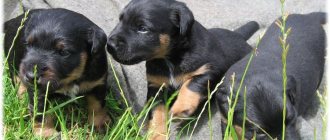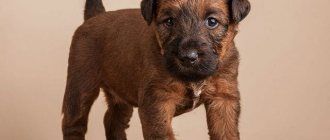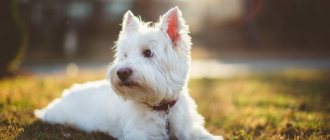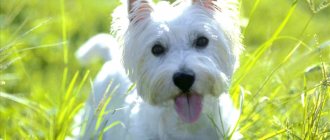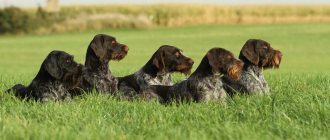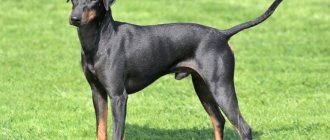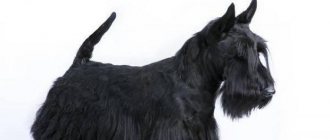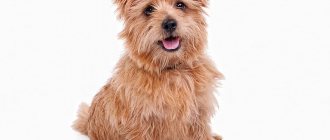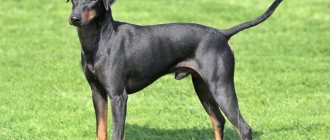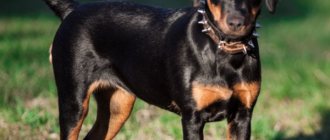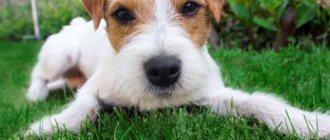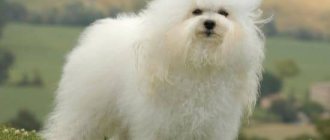Breed characteristics
| Short description | |
| Origin: | Germany |
| Conditions of detention: | Country house with a large plot, apartment |
| Purpose: | Hunter |
| Color: | Black or brown and tan |
| Wool length: | 2 – 4 cm |
| Adult dog size: | Height 34 – 39 cm, weight 8 – 10 kg |
| Average life expectancy: | 13 – 15 years |
| Walk: | Mandatory, daily |
| Physical activity needs: | High, from 3 hours a day |
| Fédération Cynologique Internationale (FIC) classification: | Group 3, section 1 |
| Puppy price: | From 5,000 to 35,000 rubles |
Application
The Jagdterrier dog was bred to hunt burrowing game, but many owners train it in other ways:
- excellent sense of smell allows the Jagdterrier, like a Russian or Estonian hound , to find wounded prey;
- when hunting wild boar, dogs show great anger and aggression;
- thanks to its love of water, it is used for searching and serving shot game, as well as when hunting birds in the forest;
- It is also possible to use Jagdterriers, like the Hungarian Vizsla , for hare hunting.
The Jagdterrier is very nimble and fast, so it will be irreplaceable in various types of hunting.
History of the origin of the species
The history of the breed is not shrouded in myths and legends, due to the relative youth of the species - Jagdterriers trace their gene pool from fox terriers rejected for color. In the 20s of the 20th century, exhibitions became fashionable, and the selection of fox terriers was aimed at the exterior, which significantly reduced the working qualities of the dogs. Walter Zangenberg, a hunter and owner of fox terriers, was disappointed with the new characteristics of the breed, and was inspired by the idea of breeding a new species - ideal for hunting.
To the defective fox terriers, Walter mixed the genetic codes of English wire-haired terriers, Welsh terriers and other dogs with first-class working qualities, relegating appearance to the background. In just 10 years, Zangenberg managed to get two hundred black and tan dogs of the same type, which he named German Jagdterrier . But the International Canine Federation accepted the breed only in 1954.
Character of the German Jagd Terrier
It is important to understand that the German Jagd Terrier does not exist outside of hunting, so buying a dog for yourself, children, or “for the sofa” and expecting aristocratic manners from it is not the most logical thing to do. However, even a yagd who regularly goes into the forest and works on animals is still obstinate. So say goodbye to the dream of making your pet an obedient “deliver” of slippers - this breed loves to cooperate, but not to serve and fawn.
The one who stole my heart
It is believed that professional training and early education can dampen the aggression and stubbornness of German Jagd Terriers, but there are also nuances here. Yes, a dog can be weaned from the habit of attacking strangers, but even an experienced dog handler will not be able to make him fall in love with a cat or another pet furry dog. Berries also attack small wild animals. For example, in rural areas, one of the main victims of the breed are hedgehogs. The black-and-tan “gladiators” are not stopped by either needles or the injuries they cause - reprisals against the prickly enemy are carried out immediately and to the bitter end.
It's the same story with unfamiliar dogs. German Jagdterriers have a strategic reserve of courage and the same amount of recklessness, therefore they are capable of provoking a conflict with their fellow tribesmen without any reason. The breed also has no time to understand the hierarchical system of the canine world, so even Yagd puppies easily go to extremes, such as encroaching on someone else’s bone or furiously attacking an adult wolfhound. Moreover, the larger the opponent, the more chances he has to infuriate the terrier - the impressive size of the opponent evokes a mixture of black envy and hatred among the “Germans”.
In a relationship with a person, Yagd prefers not to be scattered, but to concentrate on one person. Usually this is the one with whom the animal goes baiting and hunting. The dog recognizes the rest of the family members insofar as it is not in a hurry to fulfill their demands. The companion qualities of the breed are also tied to working instincts. The Jagdterrier will behave obediently during a walk only if there is someone nearby under whose leadership the animal is accustomed to hunting game. With all other household members, “feedback” will be episodic, so you can let your ward off the leash in the park in one and only case - if this park belongs specifically to you and there is not a single representative of wild fauna in it.
Distinctive features
Description of the German Jagdterrier breed:
- General form. A strong, compact dog with a slightly stretched format.
- Height. At the withers, males have 34–40 cm, females 33–39 cm, weight 8–10 kg and 7–9 kg, respectively.
- Head. Small, wedge-shaped, tapering towards the nose. The occipital protuberance and the transition from the forehead to the muzzle are poorly defined. The eyes are symmetrically located, the shape is close to almond-shaped, brown or dark brown in color. The ears are small, triangular with a crease in the cartilage, set high and close to each other.
- Muzzle. Narrow, nose black or brown, lips tightly fitting. Scissor bite, jaws strong, teeth tightly clenched.
- Neck. Dry, without dewlap, with pronounced muscles.
- Frame. Compact but muscular, lacking dampness. The stomach is tucked in, the back is straight and strong. The ribs protrude slightly, the chest is moderately wide, descending to the level of the elbows.
- Limbs. Straight, parallel, fingers closed. The thighs are strong, muscular, the hock joints are well defined.
- Tail. It is docked and 2/3 is left. Set on moderately, in an excited state the dog holds it above the level of the back.
- Coat and color. The coat is thick and dense, in two variations - wire-haired and smooth-haired. There is very little undercoat. Colors are black or brown and tan.
Sexual dimorphism is moderately expressed and is welcomed in exterior assessment.
What does a German Hunting Terrier look like?
The priority in the selection work was to breed a dog with ideal working qualities, so the result of selection was reflected in the animal’s exterior. A striking difference is the pronounced sexual dimorphism. A strong and muscular constitution is more typical for males. Females are small in size, their physique is more graceful. Their weight ranges from 7.5 to 8.5 kg. Males have a body weight of 9-10 kg. The height of the German Jagdterrier reaches 33-40 cm. Regarding the type of coat, representatives of the breed can be smooth or wire-haired.
Wirehaired
The coat of this type of yagd is denser, tougher and elongated. The guard coat forms decorations in the form of a beard and small fringes. This is an external difference from smooth-haired individuals. The wool is coarse and feels that way to the touch. The Wirehaired Jagdterrier looks disheveled in appearance. In addition to a tousled beard, the pet has elongated hair on its belly and paws. You can't help but notice the animal's charming eyebrows.
Smooth-haired
Unlike the previous type, smooth-haired jags have dense short hair. It has no undercoat and lies very close to the body. The fur is evenly distributed over the entire body of the animal. It is distinguished by a pronounced natural shine. Smooth-haired dogs look neater and smoother. The standard identifies an intermediate option - the brocken, which does not have completely smooth or hard hair.
Photo of an adult dog
Health
The Jagdterrier is an amazingly healthy dog with a strong immune system. Having received preventive vaccinations on time, he almost never gets sick.
The exception is injuries that a dog may receive while hunting.
For a dog's longevity and well-being, it is important to feed your pet correctly, provide sufficient exercise and care for it.
It is also necessary to periodically treat for helminths and protect against parasites (ticks, fleas).
Vaccinations
The Jagdterrier is vaccinated in the same way as other hunting breeds.
Rabies vaccinations are required
- coronavirus infection;
- leptospirosis;
- parvovirus enteritis;
- carnivore plague;
- adenovirus infection;
- infectious hepatitis.
Of course, the Jagdterrier will become not only a good hunting assistant, but also your best friend
You can also vaccinate your dog against dermatomycoses - trichophytosis and microsporia.
It is best to give injections at a veterinary clinic; the doctor will help you select effective polyvalent vaccines and draw up a vaccination schedule.
Photos of puppies
Possible diseases
The Jagd Terrier breed is one of those lucky breeds that do not carry virtually any genetic diseases. Of course, this does not mean that the owner has the right to calm down and forget the address of the veterinary clinic. Even these “tough nuts” can sometimes catch a cold, get hurt, or be poisoned by something. In any case, if your pet suddenly becomes uninterested in the world around him, he lies down and refuses to eat, you need to contact a specialist.
Self-medication and indifference to the dog’s health will sooner or later lead to its death. Like any other dog, the Jagdterrier requires timely vaccinations, deworming and preventive examinations. Particular attention should be paid to your four-legged friend after returning from hunting. It is necessary to examine his skin for the presence of parasites, scratches and wounds. If the owner notices something serious, there is no point in delaying a visit to the veterinarian.
Smooth-haired Jagdterrier photo
Attitude towards children
Wary. This is a serious dog, which is entirely aimed at working with the hunter. Yes, she can communicate with children, but only those who are part of her “pack”. All other berries are not interesting and cause a slight wary reaction. But even with your kids, it is better not to leave representatives of this breed alone.
The same rule applies to communication with teenagers. Walking together should not be allowed, as the yagd is very strong and can break free from your hands, deciding to sort things out with a passing enemy.
German hunting Jagdterrier: description, photo, characteristics
Features of behavior
As befits a real hunter, the Jagdterrier is distinguished by exceptional energy. This is a dog who never sits still. And if the energy is not directed in a peaceful direction, the child begins to look for things to do on his own - chewing furniture, digging holes, chasing cats. It is absolutely not suitable for lazy and melancholy people, but in hunting or sports the breed has no equal.
To this day, the Jagdterrier has retained amazing working qualities. This dog has an excellent sense of smell, endurance and a desire to work, thanks to which the breed is gradually moving from a burrow hunter into the category of universal hunters. Yagi are capable of hunting small burrow predators, swamp and steppe game, and ungulates with equal success.
The German Hunting Terrier cannot be called a dog with high communication skills. The breed does not get along well with other animals (especially rodents or birds); due to its innate leadership qualities, the dog can start fights on the street with other dogs. Treats strangers with caution, but without excessive aggression. Although with a good level of early socialization this deficiency can be reduced, it cannot be completely eradicated.
Another feature of the breed is courage, absolute and sometimes reckless. When going out to fight a predator, or defending a dog’s owner, the instinct of self-preservation is completely turned off. Which is fraught with injury, since the Jagdterrier’s opponent’s size never stops him; he is ready to fight to the death with anyone.
The breed is not suitable for novice dog breeders; it has a complex character. During educational processes, a poorly motivated child often displays remarkable stubbornness and self-will. And with harsh correction methods, he may snap back. Hunting breeds that do not know how to show independence in real hunting conditions are doomed to death; in Jagdterriers it is this trait that complicates the educational process.
Advantages
The German Hunting Terrier has a lot of advantages:
- Intelligence and quick reaction;
- Irrepressible energy;
- Strength and endurance;
- Good hunting instinct;
- Excellent hearing and sense of smell;
- Courage;
- Ability to make independent decisions;
- Compact dimensions;
- Easy to care for;
- Good health;
- Good security qualities;
- Unpretentiousness in content.
All the advantages of this little dog cannot be included in one list.
Flaws
Of course, despite all the advantages of the breed, there are also disadvantages:
- Poor level of communication;
- Hyperactivity;
- Lack of self-preservation instinct;
- Difficulty in training;
- Stubbornness;
- Frequent injuries.
Unbridled energy, splashing from a small body, from an advantage, easily turns into a disadvantage, if the content is inappropriate for this breed.
Education and training
The German Jagdterrier is a breed that needs to be raised “yesterday.” It is recommended to use traditional methods, but with an eye on the yagds’ tendency to dominate, which is expressed in biting family members, suppressing other animals, and attacking random passers-by. So, in the process of training, do not forget to instill in the dog respect for yourself and your household, showing it that the boss’s chair has been occupied for a long time.
Gentleman on a walk
Intellectually, the Yagdas may not be geniuses, but they are quite smart comrades, so they do not have any difficulties remembering commands. At the same time, perfect adherence to the “charter” is not their strong point. As an example: it is possible to train a German Jagd Terrier OKD in six months, but it is pointless to demand from him the endurance and diligence of a German Shepherd. Moreover, you should be lenient towards your pet’s mistakes: after all, you chose the ideal hunter, not a circus performer and watchman. However, you shouldn’t condone it either. Basic OKD commands will later come in handy when hunting, since they can be used to control the dog’s behavior.
The critical age for representatives of the breed is 6 months. It is during this period that the German Jagd Terrier begins to test the owner’s patience with renewed energy. There is no need to cancel the training of angry teenagers, but if there is a lack of personal experience, it is better to involve a professional. An obligatory part of the program in raising and training a Jagd Terrier is accustoming to a collar, leash and muzzle. The breed does not favor the latter accessory, but without it it is dangerous to let the four-legged rogue out into the street if you do not want to later save stray cats and conflict with passers-by who are shocked by the Yagda’s attacks.
Approach the process of putting on a muzzle carefully, without haste. Experts recommend first letting your dog sniff the device, and also placing your pet’s favorite treat inside the mesh. Time should also be allowed to get used to the muzzle. In the first days, 2-3 minutes of wearing the restraint will be enough, then the duration of use can be increased to half an hour or more.
Care and maintenance
The ideal housing option for a German Hunting Terrier is a country house with a large and securely fenced area. But a spacious area for a splash of energy does not mean that you don’t have to exercise your dog; out of boredom, the dog will dig holes and gnaw trees and bushes on the site. Having your own reservation does not eliminate the need to walk and socialize the yagda.
The compact dimensions of the breed allow you to keep the yagda in an apartment, but subject to daily active walking for at least 3 hours a day.
Otherwise, caring for a Jagdterrier is not a hassle:
- Clean your ears from dirt once every two weeks;
- Brush your teeth once a month;
- Carry out a preventive dental examination at the veterinarian twice a year;
- Once a week, wipe your eyes with a special lotion;
- Carry out preventive deworming once a trimester;
- Vaccinate against infectious diseases once a year;
- As necessary, carry out ectoparasite prevention.
In fact, this is a minimum set of procedures for caring for a dog.
Nutrition
The recommended feeding regimen for dogs is presented in the table:
| Age | Mode |
| 1 – 3 months | Fractional feeding in small portions every 3 hours 6 – 7 times a day |
| 3-5 months | 5 times a day |
| 5 – 7 months | 4 times a day |
| 7 – 11 months | 3 times per day |
| 11 or more months | It is acceptable to switch to the adult dog’s regimen – 2 feedings per day |
As for the diet, the choice is up to the owner - Jagdterriers are healthy dogs, the owner’s task is only to maintain the animal’s condition with decent nutrition.
Dry food of good quality costs a lot of money, but decent feeding with natural products takes a lot of time, and financially it doesn’t work out much cheaper.
Authorized products:
- Meat (any except fatty variations - lamb and pork) and offal (any except kidneys and liver). Should form the basis of the diet. A carnivore does not need to cook meat.
- Fish. Any varieties of white sea fish without bones, it is enough to give once a week.
- Fermented milk. With fat content no higher than 5%.
- Eggs. Only the white is better; boiled yolks have a lot of sugar.
- Cereals. The source of complex carbohydrates is oatmeal and rice, but no more than 10% of the total diet; the dog will not receive anything useful except excess weight if there is an excess of cereals.
- Cartilage and tendons. Also in raw form, very rich in protein.
- Vegetables and unsweetened fruits. Only in fresh form, otherwise they have no vitamin value.
Prohibited Products:
- Sweets, including sweet fruits (such as grapes)
- Flour products. With the exception of dried rye bread.
- Sausages and smoked meats.
- Salt and spices are also not needed by the predator.
- Marinades.
- Sharp or tubular bones.
All these products can cause acute and chronic diseases of the stomach, pancreas or injure the esophagus. And cereals such as millet, semolina, and pearl barley are not digestible in the dog’s body.
We recommend that you read a detailed article on the topic: “How and what to feed a dog: types and characteristics of nutrition.”
Health
Breeders, when breeding the breed, tried to avoid common genetic diseases - successfully . Today, breeders actively continue to work to maintain the state of the gene pool in the same form. Sick individuals (both physically and mentally) are completely excluded from breeding. Thanks to this, with proper care, Jagdterriers can easily live up to 14 - 15 years , without age-related or breed-related ailments.
The only problem that the owner of a jagda may encounter is injuries received in fights with wild or other domestic animals.
Vaccinations
- The first veterinary procedures must be carried out by the breeder - at about 6 weeks, prevent helminths for the entire litter, and after 2 weeks, double deworming.
- By the 10th week of life (no later), the owner must provide a vaccine against a minimum set of viral infections - enteritis, Carré's disease and viral hepatitis.
- Additionally, your veterinarian may prescribe another vaccine against a disease found in a particular region.
- After 28–30 days , a double vaccination is given to strengthen immunity. If the puppy is healthy and active, they immediately give an injection for rabies. If the dog lives in “greenhouse” conditions, the doctor may postpone the rabies vaccination until the teeth are completely replaced.
- After revaccination, it is recommended to observe another 2 weeks of quarantine.
- The last puppy vaccination is given at the age of 12 months . Then, every year, immunization against rabies and viral infections is carried out (with one or two sera).
Preventive deworming is carried out before each vaccine.
On the days of veterinary procedures, the pet may experience lethargy, drowsiness, lack of interest in active games, one-time refusal to feed, and even one-time vomiting. Allergic reactions to modern medications practically do not happen.
Important article on the topic: “Everything you need to know about dog vaccinations.”
Diseases
There is no visible tendency towards genetic diseases. Completely healthy breed.
Walk
Regardless of living conditions (house, enclosure, apartment), the Jagd Terrier requires a mandatory daily walk - at least 3 hours a day. At the same time, the pet needs not only to run, but also to receive mental exercise. Without a proper outburst of activity, the dog is inclined to exhibit destructive behavior.
Even working dogs that go fishing during the season are recommended to simultaneously engage in obedience walks or canine sports. The breed is perfect for canicross, frisbee dog, agility, and bikejoring.
Grooming
To care for the coat of a Jagdterrier, no special skills or equipment are required - it is enough to comb out dead hairs with a slicker brush or furminator once a week, during the period of seasonal molting - every other day.
Bathing procedures are also not required too often, especially if the dog lives in an enclosure. Berries need to be washed no more than 3-4 times a year, but for dogs kept in enclosures, one wash per year is enough.
How much does it cost and where to buy
The Jagdterrier is a very popular dog in Russia. Hunters appreciated their working qualities back in the 80s and took care of the safety of the livestock.
The best place to purchase jagd is a specialized nursery. It not only ensures blood purity, but also provides social skills. Terriers are difficult dogs to train. Their socialization begins from the first days of life. Puppies purchased from private owners are often embittered due to the neglectful attitude of their owners.
In addition, they may turn out to be a cross between two hot breeds, which will not be easy to raise. The most common mixed breed Jagdterrier is the dachshund. There are known cases of mating with a Yorkshire terrier.
List of nurseries:
- Estronold (Moscow);
- From Udelnaya Okhota (St. Petersburg);
- Batyr (Moscow);
- Ural Hunter (Ekaterinburg);
- Donskoy Okhotnik (Rostov-on-Don);
- Khazar (Astrakhan);
- Nursery Conversions (St. Petersburg);
- Russian Wind (St. Petersburg).
Average price for puppies: 15,000-30,000 rubles.
Nicknames for boys: Argus, Barney, Bars, Vist, Gore, Grimaud, Dick, Zorro, Luke, Nero, Nord, Orestes, Oscar, Pongo, Rocky, Sirius, Sherkhan, Jaken.
Nickname for the girl: Arma, Storm, Vesta, Hera, Della, Zara, Kira, Clara, Lori, Morena, Norna, Bullet, Ruma, Ursula, Fira, Hora, Sheba, Yara, Jasper.
Similar breeds:
- fox terrier;
- Jack Russell Terrier;
- dachshund, airedale terrier;
- border terrier;
- Welsh Terrier;
- Lakeland Terrier.
These breeds belong to burrowing dogs and have similar working qualities.
Jagdterrier or fox terrier
Both breeds are excellent watchdogs and hunters. Fox terriers are careful in the hole, trying to avoid being bitten. Jagdterriers are crazy dogs: they don’t think about the size of their opponent and are ready to grab onto anyone. This often results in death and serious injury. Jagda and Fox are only walked on a leash. Otherwise, they may tear apart the cat or tangle with the dog. Foxes tend to bite strangers and even their owners. The Yagds, although they treat strangers with suspicion, are in no hurry to test their teeth.
Fox Terriers have a spectacular and attractive appearance, so they are kept as decorative pets. Jagdas look much more modest: first of all, they are hunting dogs. Foxes often live to old age due to some cowardice. The yagdy would rather die on the hunt, fighting another beast, than from old age or illness. This can be a real tragedy for a loving owner.
Mating
According to the regulations on breeding work published on the website of the Russian Cynological Federation, completely healthy individuals who have reached the age of 18 months are allowed to breed . In females, this is usually the third estrus.
A prerequisite for mating is to meet a male on the territory; females often behave aggressively on their reservation.
Mating is prescribed on days 9–14 of estrus ; depending on the characteristics of the body, ovulation does not occur on a specific day. To obtain reliable information about readiness for mating, it is recommended to take a special ovulation test (the male is ready for mating all year round). Before mating, both individuals need to be treated against parasites and vaccinated.
Read a detailed article on the topic: “Everything you need to know about breeding dogs: appropriate age, what to do if it doesn’t work out, rules and tips.”
Character and psychology
The intelligence and excellent learning ability of this active dog will not leave anyone indifferent.
Among the features are:
- A sharp mind, thanks to which you can quickly train a dog and instill in it the necessary qualities;
- Courage, fearlessness;
- Distrust of strangers. It is important to correctly form the character of the Jagdterrier in order to avoid aggression;
- Endurance, strong constitution;
- He receives extraordinary pleasure from working and executing his master's orders.
Excellent sense of smell allows the Jagdterrier to quickly find prey
Key points in training
Due to their natural increased activity and some stubbornness, training a German Hunting Terrier is a troublesome task. But the breed is quite smart, and with the right approach, it can be trained well. The owner will have to choose his motivation very carefully and become even more stubborn than the pet . Skill development should be short, but daily , and based solely on positivity, then success will be ensured.
The Jagdterrier knows his own worth and will not allow cruelty and tyranny towards himself. For beginner dog breeders, it is better to contact a professional instructor for questions about breed training.
Read about how to properly train a dog in the article: “Training a puppy: effective methods from dog handlers, learning commands at home.”
Key facts
The Jagdterrier is a small dog with exceptional working qualities and an independent character. From the early years of life, the animal tries to suppress the owner, and over the years this tendency only intensifies. The dog can use its teeth, so the owner must have a strong will to overcome the desire to dominate.
The Jagdterrier is suitable for active families, as it requires long and frequent walks with good physical activity. The dog will not be able to sit in a cramped apartment for a long time.
Description of the Jagdterrier breed combines:
- activity, energy;
- courageous, decisive, independent character;
- endurance, aggressiveness towards prey;
- devotion to the owner;
- skill and coherence in work;
- good learning ability.
It is better to place the Jagdterrier in the enclosure of a private house: then he will reliably protect the local area entrusted to him from the penetration of strangers. If the dog is forced to live in an apartment, it is worth setting aside a place protected from drafts, otherwise he will suffer from colds.
Characteristics of the Jagdterrier breed highlight the following character traits - excellent flair, endurance, anger, the ability to hunt on water and underground, perseverance, toughness and fearlessness in battle. All these qualities are needed by a hunting dog, but the terrier should not be considered as a companion.
With proper maintenance, care and proper nutrition, the life expectancy of Jagd Terriers is about 14 years. Caring for a dog cannot be called difficult; special attention should be paid only to the animal’s ears. This is especially true in the spring, when there are a lot of ticks on bushes and trees in parks and forests.
Cost and choice of puppy
Since the breed is absolutely not commercial, prices for Jagd Terrier puppies are quite affordable. For 25,000 - 35,000 rubles you can buy a worthy representative, in a professional nursery, from working parents. A puppy without documents costs from 5,000 rubles . But without a pedigree, cynological organizations do not recognize the breed and permission to hunt cannot be obtained.
It is better to buy a future pupil from a nursery that has good reviews . When getting to know the litter, you need to pay attention to the living conditions and health status of the dogs. It’s good if the breeder has documents confirming the absence of genetic diseases.
Basic rules when choosing a Jagdterrier:
- It is unacceptable for small puppies (without vaccinations) to roam freely around the yard - there is an increased risk of contracting a helminthic infestation.
- No hernia in the navel area.
- Clean, shiny coat, without signs of bald patches, dandruff, or dermatitis.
- The puppy must be at least 6 weeks old when sold.
- Absence of all kinds of discharge from the ears, nose, eyes.
- Availability of a veterinary passport with notes on all events.
Upon visual inspection, the future owner of the puppy should not have the slightest doubt about the pet’s health (both physical and psychological).
German Jagd Terrier price
Club German Jagd Terrier puppies from parents with working diplomas and a package of documents will cost 15,000 - 20,000 rubles. If field trials and going to exhibitions are not planned, you can turn to familiar hunters who periodically mate their charges. Such berries cost much less, around 5000-8000 rubles, but in terms of working qualities they are not inferior to offspring from champion producers. The only caveat: puppies from a non-professional breeder may not have puppy metrics, which casts doubt on the purity of the litter.
Hunting with a Jagdterrier (video)
Before going out to hunt, the dog needs to be baited on the animal, in other words, prepared for the difficulties of real hunting, despite the innate hunting qualities of the Jagdterrier.
There are two types of baiting:
- Passive - without the direct participation of a wild animal.
- Active - with the help of a live decoy animal.
At the baiting stations there are professionals who will help the novice hunter in preparing the dog for work. Active baiting begins at the age of 6 – 7 months , passive baiting even earlier – from 3 – 4 months .
The German Hunting Terrier specializes in burrow hunting for foxes, raccoons, and badgers. Thanks to their good sense of smell, quick reaction, strong grip and intelligence, representatives of the breed are actively used for hares, martens, ungulates and feathered game.
Jagdterrier vs wild boar
Despite the fact that the yagd is considered a burrow hunter, its exceptional fearlessness and powerful jaws have made the breed a generalist. In a fight with a wild boar, a small dog is not inferior to a husky. Video evidence:
Health and diseases of German Jagd Terriers
Like most working breeds, German Jags do not suffer from excessive illness and do not inherit dozens of genetic ailments from their parents that interfere with an active life. An exception to the general rule is lens displacement, which is inherent in all representatives of the terrier group, and Ehlers-Danlos syndrome. The latter disease also occurs in other breeds and is expressed in excessive elasticity and sagging skin.
To this day, Ehlers-Danlos syndrome has no cure, so the only thing that can be done for an animal with such dermal lesions is to minimize the risk of injuries and tissue ruptures, which the veterinarian will then have to stitch up. German Jagd Terriers are not immune to infectious and viral diseases, so do not neglect vaccinations against distemper, rabies and piroplasmosis. This is especially true for dogs that regularly hunt and are at risk of contracting the disease from wild animals and ticks.
Owner reviews
- Oleg:
“I have been interested in hunting and working Jagdterriers for a long time. An ideal working dog, simply irreplaceable on the hunt - strong, brave, stubborn. But in the “off-season” she gets very bored, you need to work with her constantly - training, long walks and races with a bicycle, training - a vital need for the breed. I don’t recommend buying it as a sofa companion, the Jagdterrier must work. Hunting is his passion and purpose in life.”
- Irina:
“We took Yagda into the apartment, but we have a big family and there is always someone at home, this became a salvation. Alone, our fidget cannot sit at all, she is very bored and mischievous. We love noisy outings into nature, trips to the country, to the forest to pick mushrooms - for Nika (that’s our girl’s name) she is truly happy. But it’s clear that she’s bored without her dog work, she’s always trying to chase the cat in the yard, and on walks she’s always looking for voles (breaking holes and getting mice). Life in an apartment without hunting is still not for her, it’s better to take such an energizer for work.”
- Alexei.
“I bought the dog as a companion for trips into nature - I am an avid fisherman and hunter. The dog always happily accompanies me, everything suits me. The wife is unhappy that the dog chases all the cats in the yard (although there is a cat living in the apartment, the dog handler helped make peace with her) and treats guests unkindly.”
5 / 5 ( 1 voice )
Pros and cons of the breed
| + | – |
| Has universal hunting characteristics | Has a tendency towards aggression |
| With proper upbringing, he gets along well with children. | Uncontrollable when baiting an animal |
| Suitable for apartment living | You can't walk without a leash |
| Unpretentious in conditions of detention | Tends to question master's orders |
| Has excellent health | Needs early socialization |
| Ideal for energetic owners | May die while hunting |
| Loves agility training | Not suitable for sharing with cats and other animals |
| Sheds moderately |
The German Jagd Terrier is a complex and strong-willed dog. The breeders wanted to breed the ideal beater and hunter, so they deliberately increased natural aggression. To keep these impulses under strict control, the owner must devote a lot of time to training. A well-bred Jagdterrier will become a full-fledged member of the family and will treat children with tenderness.
Difficulties
Jag terriers tend to show aggression not only towards their prey, but also towards humans. Only people with a strong character who know how to cope with such a dog and tame it can get a dog. You need to start training your dog from an early age and not give the slightest concessions. The dog is very wayward and it will be impossible to retrain it when it grows up.
They usually hunt burrowing animals with the Jag Terrier. The structural features of the paws with large claws and strong paws enable the dog to reach animals. And thanks to the special structure of the jaw, the skin of the victim is not damaged.
Breed standard (appearance)
The proportions of the dog were created based on practical conditions, therefore the description of the breed and the characteristics of the Jagdterrier are simple appearance and exterior:
- The skull is moderately elongated, wedge-shaped, flat. The muzzle is harmoniously formed, shorter than the head.
- The neck is of medium length, with good muscle tone.
- The body is slightly elongated with a straight top of the body and a strong loin, the length of the body is not much greater than the height at the withers, the belly has a refined curve.
- The chest is deep, the girth should not exceed the height at the withers by 12 cm, the ribs are arched and laid back.
- Teeth – 42 pcs., large, smooth, brightly pigmented. Strong jaws with a tenacious grip and scissor bite are clearly defined.
- The eyes are brown, small, deep-set, spaced far apart, with a straight gaze.
- The ears are triangular in shape, hanging, set high, small in size, not very pointed.
- The front legs are parallel, round in shape with rough, dense pads, have strong bones, dried muscles, elongated slanting shoulder blades, steep forearms and elbows without eversion.
- Hind feet with strong knees, shins, thighs and hard pads on the toes.
- Wool – The covering hair has a coarse, dense texture.
- The tail is straight, curved, like a saber, docked by one third.
Important! The tip of the tail should not deviate towards the back. During a burrow hunt, the owner should be able to pull the angry dog out of the ground precisely by this part. But this parameter does not affect the cost of puppies, since in some countries the docking procedure is completely prohibited.
Popular colors of German Jagd Terriers
Color of the Jagdterrier
There are two variants of the coat: smooth-haired Jagdterrier and wire-haired. The first one has an even covering hair. The Wirehaired Jagd Terrier is distinguished by disheveled guard hair on the chest and a protruding beard, similar to that of the Fox Terrier. The most common color is black and tan. The nose is usually black, but a coffee tint is acceptable for individuals with the same coat color. Also found:
- brown with slightly lighter ends;
- tan and gray;
- black with red and gray;
- completely dark brown;
- smooth-haired completely black.
In both long-haired and smooth-haired coats, dark gold or red tan markings are allowed. They have clear boundaries and are located at the base of the tail, on the eyebrows, the front of the head, the chest, and the ends of the legs. The color is complemented by a dark or whitish mask and white spots in the toes and chest.
